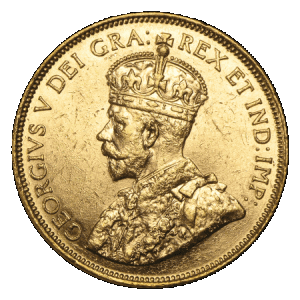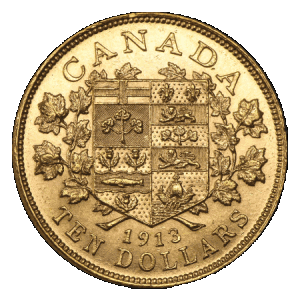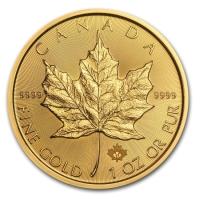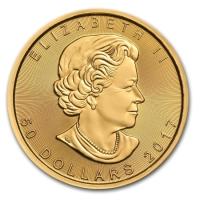Canada $5/$10 George V Gold Coins

 Canadian George V gold coins - Canada's first gold coins
Canadian George V gold coins - Canada's first gold coins
The Canadian George V gold coins were the first gold coins to be minted in Canada. So, when you buy gold in the form of these coins, you'll own a piece of history. The mint in Ottawa had just been opened in 1908 as a branch mint of London's Royal Mint. Mintage of the $5 and $10 George V gold coins started in 1912 and lasted only for a short time until 1914. Almost two decades later in 1931, the Ottawa Mint was renamed as the Royal Canadian Mint that is now famous for producing bullion coins like the Canadian Gold Maple Leafs.
Due to the very short mintage period and the resulting low mintage numbers, both the $5 and $10 George V gold coins are nowadays very rare gold coins. However, the Royal Canadian Mint recently made about 30,000 such coins available that had been in storage at Bank of Canada vaults. Additional coins are unlikely to be released as any remaining coins in the vaults are scheduled to be melted down.
The composition of both denominations of these historic Canadian gold coins is 90% gold and 10% copper as is customary with gold coins from this period. The $10 George V gold coin contains 0.4837 oz of gold and the $5 George V gold coin contains 0.2419 oz. The coins depict a portrait of King George V as well as Canada's coat of arms. American buyers that are investing in gold for their retirement should take note that the coins are not eligible for inclusion in Individual Retirement Accounts (IRA's) since they are classified as collectible gold coins by the IRS.


Coin Fact Sheet
| Weight | Face Value | Purity | Diameter x Thickness |
|---|---|---|---|
| 0.4837 oz | CAD $10 | 90% | 27 x 2.08 mm |
Total Mintage: 289,300
| Weight | Face Value | Purity | Diameter x Thickness |
|---|---|---|---|
| 0.2419 oz | CAD $5 | 90% | 22 x 1.82 mm |
Total Mintage: 295,634
Design of the Canadian George V coins
The obverse side of the Canadian George V coins depicts King George V in profile wearing his ceremonial robe and royal crown. The British monarch George V reigned from the 6th of May 1910 until his death in 1936.
The inscription "CANADA" appears above a shield bearing the Arms of the Dominion of Canada on the reverse side of each Canadian George V gold coin. Since 1868, this was the de facto coat of arms of Canada until King George V proclaimed its replacement in 1921. A wreath of maple leafs surrounds the shield on both sides and the coin's denomination of either 5 or 10 Dollars appears below it along with the year of issue. The shield displays the provincial symbols of the four provinces Ontario (St. George's cross with maple leaves), Quebec (pair of fleurs de lis with British lion and maple leaves), Nova Scotia (salmon and Scottish thistles) and New Brunswick (British lion and sailing ship).
History of the $5/$10 Canadian George V coin
British parliament permitted the establishment of a mint on Canadian soil with the Ottawa Mint Act in 1901. However, it was not until 1908 that the Ottawa Branch of the British Royal Mint opened on Sussex Drive. Its intended purpose was to refine Canada's mined gold and convert it into gold coins as well as to produce Canadian domestic coins and British sovereigns. The mint in Ottawa received permission to produce $5 and $10 gold coins with Canadian imagery two years later, after the construction of a much needed refinery had already begun in 1909. Although the refinery was already complete in January 1911, the start of gold coin production was delayed until 1912 by the death of King Edward VII as well as indecision regarding the design of the coins.
The coins were meant to be distinctly Canadian. All the used gold came from Canadian sources, mostly from the Klondike region in 1912 and the Ontario region in 1913 and 1914. The design used Canada's de facto coat of arms on the reverse side. Production of the $5 and $10 gold coins, Canada's first gold coins ever, continued until the outbreak of the First World War in 1914. The mint replaced the gold coin production with the production of gold bars in 1915.
Many of the circulating $5 and $10 gold coins were recovered by the Canadian government. They were used to finance the war effort along with remaining stocks that had been withheld from circulation. The Bank of Canada kept the remaining coins in cloth bags for more than 75 years in their vaults. The Royal Canadian Mint recently started selling a collection of these historic coins. Out of a collection of about 245,000 George V $5 and $10 gold coins, 30,000 were hand-selected to be sold to the public. The remaining coins out of this collection will be melted and refined into pure gold by the Royal Canadian Mint.
Mintage Numbers
The Canada $5/$10 George V gold coins were only minted between 1912 and 1914. Total mintage of the Canada $5 George V gold coin slightly surpassed that of the Canada $10 George V gold coin. The lowest annual mintage of the $5 coins were the 31,122 coins that were minted in 1914. The lowest annual mintage of the $10 coins were the 74,759 coins that were minted in 1912.


Canadian Gold Maple Leafs
The Royal Canadian Mint produces the Canadian Gold Maple Leafs since 1979. The coins were minted out of 99.9% pure gold until 1981. Since then, they are 99.99% pure and some special editions of the coins are even minted out of 99.999% pure gold! The Canadian Maple Leaf gold coins that count among the most popular gold bullion coins worldwide are available with brilliant uncirculated and proof finishes in a wide range of denominations between 1 gram and 1 oz. Special security measures also make the coins extremely hard to counterfeit. These include micro-engraved radial lines as well as a textured maple leaf privy mark that has the last two digits of the year of mintage laser-engraved.
The Canadian Gold Maple Leaf page gives more information about the coins and allows you to compare current prices.